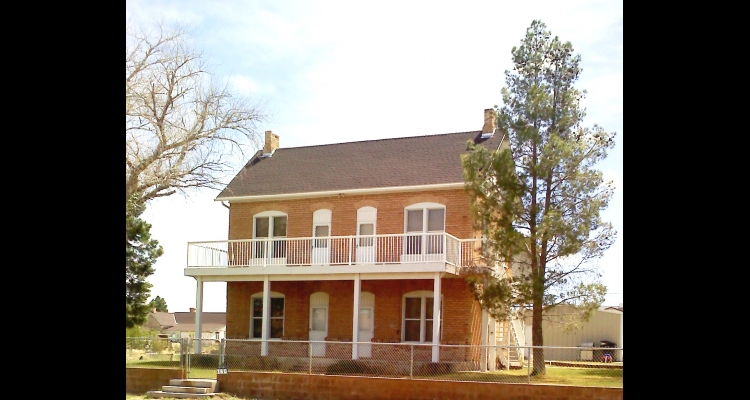Leavitt House, Bunkerville, Clark County
Thomas Dudley Leavitt and twenty-two other Latter-day Saints established the utopian community of Bunkerville in 1877 under the leadership of Bishop Edward Bunker. Founded on the principles of the "United Order," their economic system relied on cooperative labor and communal property ownership, which were principles received by Mormon founder Joseph Smith in what he said was divine revelation. Smith's successor, Brigham Young, had more faith in the tithing system, but he allowed the settlement anyway. Leavitt built a two-story brick home in Bunkerville for his first wife, Louella.
The United Order dissolved by 1880, but the community as a whole endured and slowly grew. The settlers dug irrigation canals and established a flour mill. The 1880s saw construction of a brick kiln and a mortar-producing lime kiln. Thomas Leavitt also thrived in this period. He grew grain and raised cattle, sold molasses, and owned a thresher, which he used to thresh grain for local farmers. Prominent in the Mormon Church, he advised Bishop Bunker and counseled in Sunday school. By 1896, Thomas had taken a second wife, Ada, the family had grown to three adults and thirteen children, and their frame house could not stand the strain. Polygamy was part of the original teachings of the Church of Latter-day Saints.
Using locally available bricks and mortar, Leavitt built a vernacular T-shaped house, two stories high and one room deep, with chimneys in each gable end. Two-story wooden porches stretched across the front and along the two sides of the rear wing. A star and fleur-de-lis design cut into each window head may have doubled as ventilators. The house was characteristic of those built by Mormon settlers spreading from Salt Lake City up to Idaho and down to Southern Nevada. Particularly characteristic were the many exterior doors. The front facade had two paired sets of entrances, one pair on the ground floor and another opening onto the second floor of the porch. The house originally had twelve exterior doors, six on each level. In large polygamous family homes, the multiple doors allowed circulation while maintaining a modicum of interior privacy in a house with no hallways.
Despite all the doors, even this house could not hold the still-expanding family. It became Louella's home and the family acquired the house next door for Ada. Thomas eventually fathered twenty-two children, eleven with each wife. He and Ada remained married for forty-four years until her death in 1931. Thomas and Louella had been married fifty-two years when he died in 1933. Louella lived in her brick house until her death in the late 1940s.
Today the house, somewhat changed, sits on a large lot enclosed by a picket fence, with mature honey locust trees, chicken coops, and the original stone granary in back. It is listed in the National Register of Historic Places and retains the character of the early Mormon settlement.
Article Locations
Related Articles
None at this time.
Further Reading
None at this time.
